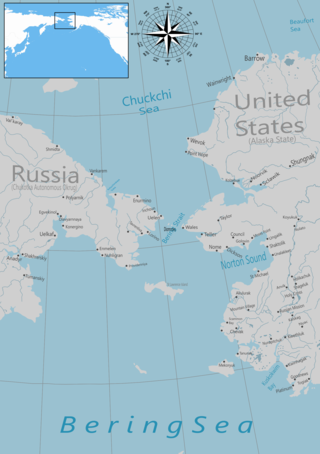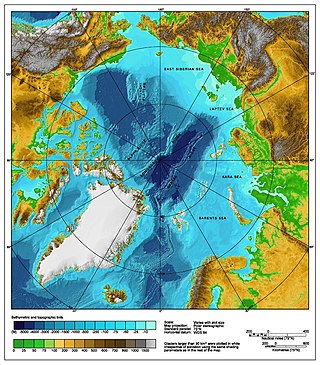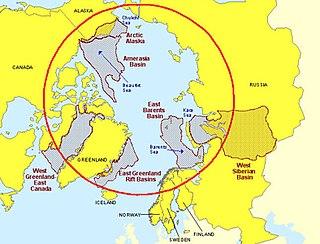Related Research Articles

The Northwest Passage (NWP) is the sea lane between the Atlantic and Pacific oceans through the Arctic Ocean, along the northern coast of North America via waterways through the Arctic Archipelago of Canada. The eastern route along the Arctic coasts of Norway and Siberia is accordingly called the Northeast Passage (NEP). The various islands of the archipelago are separated from one another and from Mainland Canada by a series of Arctic waterways collectively known as the Northwest Passages, Northwestern Passages or the Canadian Internal Waters.

The Arctic is a polar region located at the northernmost part of Earth. The Arctic region, from the IERS Reference Meridian travelling east, consists of parts of northern Norway, northernmost Sweden, northern Finland, Russia, the United States (Alaska), Canada, Danish Realm (Greenland), and northern Iceland, along with the Arctic Ocean and adjacent seas. Land within the Arctic region has seasonally varying snow and ice cover, with predominantly treeless permafrost under the tundra. Arctic seas contain seasonal sea ice in many places.

The Bering Strait is a strait between the Pacific and Arctic oceans, separating the Chukchi Peninsula of the Russian Far East from the Seward Peninsula of Alaska. The present Russia-United States maritime boundary is at 168° 58' 37" W longitude, slightly south of the Arctic Circle at about 65° 40' N latitude. The Strait is named after Vitus Bering, a Danish-born Russian explorer.

The Soviet Union incorporated an area of over 22,402,200 square kilometres (8,649,500 sq mi), covering approximately one-sixth of Earth's land surface. It spanned most of Eurasia. Its largest and most populous republic was the Russian SFSR which covered roughly three-quarters of the surface area of the union, including the complete territory of contemporary Russia.

The Northeast Passage is the shipping route between the Atlantic and Pacific Oceans, along the Arctic coasts of Norway and Russia. The western route through the islands of Canada is accordingly called the Northwest Passage (NWP).

The Northern Sea Route (NSR) is a shipping route about 5,600 kilometres (3,500 mi) long. The Northern Sea Route (NSR) is the shortest shipping route between the western part of Eurasia and the Asia-Pacific region.

The Arctic Council is a high-level intergovernmental forum that addresses issues faced by the Arctic governments and the indigenous people of the Arcticregion. At present, eight countries exercise sovereignty over the lands within the Arctic Circle, and these constitute the member states of the council: Canada; Denmark; Finland; Iceland; Norway; Russia; Sweden; and the United States. Other countries or national groups can be admitted as observer states, while organizations representing the concerns of indigenous peoples can be admitted as indigenous permanent participants.

The Arctic consists of land, internal waters, territorial seas, exclusive economic zones (EEZs) and international waters above the Arctic Circle. All land, internal waters, territorial seas and EEZs in the Arctic are under the jurisdiction of one of the eight Arctic coastal states: Canada, Denmark, Finland, Iceland, Norway, Russia, Sweden and the United States. International law regulates this area as with other portions of Earth.
The Ilulissat Declaration is a document signifying necessary joint regional efforts and responsibilities in response to the potentially adverse effects of climate change with regard to the melting Arctic ice pack.

Arctic cooperation and politics are partially coordinated via the Arctic Council, composed of the eight Arctic states: the United States, Canada, Iceland, Norway, Sweden, Finland, Russia, and Denmark with Greenland and the Faroe Islands. The dominant governmental power in Arctic policy resides within the executive offices, legislative bodies, and implementing agencies of the eight Arctic countries, and to a lesser extent other countries, such as United Kingdom, Germany, European Union and China. NGOs and academia play a large part in Arctic policy. Also important are intergovernmental bodies such as the United Nations and NATO.

The Arctic policy of the United States is the foreign policy of the United States in regard to the Arctic region. In addition, the United States' domestic policy toward Alaska is part of its Arctic policy.
Sea transport accounts for most of the European Union's external and internal commerce. The EU is the world's third-largest importer of fisheries and aquaculture products and the fifth-largest producer. Maritime borders make up more than 70% of the Union's external borders, and hundreds of millions of travelers pass through European ports each year. The security of Europe's energy supply is heavily reliant on marine transit and infrastructure. The significant expansion of EU Member States' fleets, as well as suitable port infrastructure, contribute to a well-functioning energy market and supply security, and hence to European residents' and the European economy's overall well-being. The Arctic region is therefore a vital new area for the EU to work towards and a new strategy for the Arctic region that matches with the European Green deal was established in late 2021.

The Arctic policy of Russia is the domestic and foreign policy of the Russian Federation with respect to the Russian region of the Arctic. The Russian region of the Arctic is defined in the "Russian Arctic Policy" as all Russian possessions located north of the Arctic Circle. Approximately one-fifth of Russia's landmass is north of the Arctic Circle. Russia is one of five littoral states bordering the Arctic Ocean. As of 2010, out of 4 million inhabitants of the Arctic, roughly 2 million lived in arctic Russia, making it the largest arctic country by population. However, in recent years Russia's Arctic population has been declining at an excessive rate.

The Arctic Policy of the Kingdom of Denmark defines the Kingdom's foreign relations and policies with other Arctic countries, and the Kingdom's strategy for the Arctic on issues occurring within the geographic boundaries of "the Arctic" or related to the Arctic or its peoples. In order to clearly understand the Danish geopolitical importance of the Arctic, it is necessary to mention Denmark's territorial claims in areas beyond its exclusive EEZ in areas around the Faroe Islands and north of Greenland covering parts of the North Pole, which is also claimed by Russia.
The Arctic Policy of China outlines China's approach to foreign relations with Arctic countries as well as its plans to develop infrastructure, extend military capabilities, conduct research, and excavate resources within the Arctic Circle.

Arctic shipping routes are the maritime paths used by vessels to navigate through parts or the entirety of the Arctic. There are three main routes that connect the Atlantic and the Pacific oceans: the Northeast Passage, the Northwest Passage, and the mostly unused Transpolar Sea Route. In addition, two other significant routes exist: the Northern Sea Route, and the Arctic Bridge.

Ice Exercise was a United States Navy mission in the Arctic Ocean.

The Arctic resources race is the competition between global entities for newly available natural resources of the Arctic. Under the United Nations Convention of the Law of the Sea, five nations have the legal right to exploit the Arctic's natural resources within their exclusive economic zones: Canada, Russia, Denmark, Norway, and the United States.

Arctic geopolitics is the area study of geopolitics on the Arctic region. The study of geopolitics deals with the "inalienable relationship between geography and politics", as it investigates the effects of the Earth's geography on politics and international relations. Arctic geopolitics focuses on the inter-state relations in the Arctic, which is the northernmost polar region. It is composed of the Arctic Ocean and its adjacent seas, and is home to around four million people. The states in or bordering the Arctic are commonly referred to as the Arctic Eight, and are the United States, Canada, Russia, Finland, the Kingdom of Denmark (Greenland), Norway, Iceland and Sweden.

The Arctic Five are the five littoral states bordering the Arctic Ocean: Canada, The Kingdom of Denmark, Norway, The Russia Federation and the United States of America.
References
- ↑ "World Policy blog". Archived from the original on 2016-02-05. Retrieved 2016-02-05.
- ↑ "Snow dragons: As the Arctic melts, Asia shudders at the risks but slavers at the opportunities", The Economist